Fires of a House—Burning Events in a Middle Bronze Age Vatya House as Evidenced by Soil Micromorphological Analysis of Anthropogenic Sediments
Abstract
1. Introduction
1.1. Research Area
1.2. The Vatya House ID 3497
2. Materials and Methods
2.1. Samples
2.2. Thin-Section Soil Micromorphology
2.3. Phytolith Analysis
- The Observed/Not Observed Index (O/NO) referred to the absence or presence of phytoliths within the thin section.
- The Distribution Index (D) defined whether the observed phytoliths occurred in the groundmass or in voids.
- The Morphotype Identification Index (MI) implied the identification of the plant opal particles observed in the thin sections. It relies on standard phytolith nomenclature sources such as the ICPN 2.0 [48] and on plant anatomical knowledge.
- The Aspect Index (A) considered the plant opal particles individually in terms of their visibility and appearance. Visibility referred to the fact that phytoliths might have been wholly, partly, or not at all released from the organic tissues (for details, check ESM2 in the Supplementary Materials.)
- The Associated Material Index (AM) provided additional contextual data relevant to the presence or absence of plant opal particles and defined the presence of charred plant organic matter (POM).
3. Results
4. Discussion
4.1. Burning Type #1—Hearth and Hearth-Related Activities
4.2. Burning Type #2—Cleaning Activities
4.3. Burning Type #3—The End of the House’s Lifecycle
4.4. Fire and the House’s Lifecycle
5. Conclusions
Supplementary Materials
Author Contributions
Funding
Data Availability Statement
Conflicts of Interest
References
- Harrison, K. Fire and Burning in a Neolithic Settlement: Çatalhöyük. In Çatalhöyük Archive Reports; Çatalhöyük, Turkey, 2007; pp. 273–280. Available online: https://www.catalhoyuk.com/archive_reports/2004/ar04_38.html (accessed on 20 September 2022).
- Harrison, K. Fire and Burning at Çatalhöyük. In Çatalhöyük Archive Reports; Çatalhöyük, Turkey, 2008; pp. 273–280. Available online: https://www.catalhoyuk.com/sites/default/files/media/pdf/Archive_Report_2008.pdf (accessed on 20 September 2022).
- Braadbaart, F.; van Brussel, T.; van Os, B.; Eijskoot, Y. Fuel remains in archaeological contexts: Experimental and archaeological evidence for recognizing remains in hearths used by Iron Age farmers who lived in peatlands. Holocene 2017, 27, 1682–1693. [Google Scholar] [CrossRef]
- Tringham, R. Destruction of Places by Fire: Domicide or Domithanasia. In Destruction: Archaeological, Philological, and Historical Perspectives; Driessen, J., Ed.; Presses Universitaires de Louvain: Louvain, Belgium, 2013; pp. 89–108. [Google Scholar]
- Shillito, L.-M.; Matthews, W. Geoarchaeological Investigations of Midden-Formation Processes in the Early to Late Ceramic Neolithic Levels at Çatalhöyük, Turkey ca. 8550–8370 cal BP. Geoarchaeol. Int. J. 2013, 28, 25–49. [Google Scholar] [CrossRef]
- Matthews, W. Humans and fire: Changing relations in early agricultural and built environments in the Zagros, Iran, Iraq. Anthr. Rev. 2016, 3, 107–139. [Google Scholar] [CrossRef]
- Marcazzan, D.; Miller, C.E.; Conrad, N.J. Burning, dumping, and site use during the Middle and Upper Palaeolithic at Hohle Fels Cave, SW Germany. Archaeol. Anthropol. Sci. 2022, 14, 178. [Google Scholar] [CrossRef]
- Szeverényi, V. Bronzkori „háztűznéző”. Szándékos házégetés és anyagi metaforák a Kárpát-medence kora és középső bronzkorában-Deliberate house-burning and material metaphors in the Early and Middle Bronze Age of the Carpathian Basin. In MΩΜOΣ 7. Őskoros Kutatók 7. Összejövetele 2011. Március 16–18. Százhalombatta. Ősrégészeti Levelek 13; Anders, A., Kalla, G., Kiss, V., Kulcsár, G., Szabó, G.V., Eds.; Matrica Museum: Százhalombatta, Hungary, 2013; pp. 215–232. [Google Scholar]
- Chapman, J. Deliberate house-burning in the prehistory of central and eastern Europe. In Glyfer och Arkeologiska Rum: En Vänbok till Jarl Nordbladh, Gotarc Series A; Gustafsson, A., Karlsson, H., Eds.; Göteborg University Press: Göteborg, Sweden, 1999; Volume 13, pp. 113–116. [Google Scholar]
- Schiegl, S.; Goldberg, P.; Pfretzschner, H.; Conard, N.J. Palaeolithic burnt bone horizons from the Swabian Jura: Distinguishing between in situ fireplaces and dumping areas. Geoarchaeology 2003, 5, 541–565. [Google Scholar] [CrossRef]
- Goldberg, P.; Miller, C.E.; Schiegl, S. Bedding, hearths, and site maintenance in the Middle Stone Age of Sibudu Cave, KwaZulu-Natal, South Africa. Archaeol. Anthropol. Sci. 2009, 1, 95–122. [Google Scholar] [CrossRef]
- Alperson-Afil, N. Archaeology of fire: Methodological aspects of reconstructing fire history of prehistoric archaeological sites. Earth-Sci. Rev. 2012, 113, 111–119. [Google Scholar] [CrossRef]
- Mentzer, S. Microarchaeological aproaches to the identification and interpretation of combustion features in Prehistoric archaeological sites. J. Archaeol. Method Theory 2012, 21, 616–668. [Google Scholar] [CrossRef]
- Röpke, A.; Dietl, C. The vitrified Bronze Age fortification of Bernstorf (Bavaria, Germany)—An integrated geoarchaeological approach. Eur. Geol. 2014, 38, 25–32. [Google Scholar]
- Goldberg, P.; Miller, C.E.; Mentzer, S.M. Recognizing Fire in the Paleolithic Archaeological Record. Curr. Anthropol. 2017, 58, 175–190. [Google Scholar] [CrossRef]
- Shillito, L.-M. Simultaneous thin section and phytolith observations of finely stratified deposits from Neolithic Çatalhöyük, Turkey: Implications for paleoeconomy and Early Holocene paleoenvironment. J. Quat. Sci. 2011, 26, 576–588. [Google Scholar] [CrossRef]
- Dibble, H.L.; Sandgathe, D.; Goldberg, P.; McPherron, S.; Aldeias, V. Were Western European Neanderthals able to make fire? J. Paleolit. Archaeol. 2018, 1, 54–79. [Google Scholar] [CrossRef]
- Goldberg, P.; MacPhail, R.I. Practical and Theoretical Geoarchaeology; Blackwell Publishing: Hoboken, NJ, USA, 2006; p. 454. [Google Scholar]
- Devos, Y.; Nicosia, C.; Vrydaghs, L.; Speleers, L.; van der Valk, J.; Marinova, E.; Claes, B.; Albert, R.M.; Esteban, I.; Ball, T.B.; et al. An integrated study of Dark Earth from the alluvial valley of the Senne river (Brussels, Belgium). Quat. Int. 2016, 460, 175–197. [Google Scholar] [CrossRef]
- Berna, F.; Goldberg, P. Assessing Paleolithic pyrotechnology and associated hominin behavior in Israel. Isr. J. Earth Sci. 2007, 56, 107–121. [Google Scholar] [CrossRef]
- Nicosia, C.; Stoops, G. Archaeological Soil and Sediment Micromorphology; Wiley Blackwell: Oxford, UK, 2017. [Google Scholar]
- Courty, M.A.; Goldberg, P.; Macphail, R.I. Soils and Micromorphology in Archaeology; Cambridge University Press: Cambridge, UK, 1989. [Google Scholar]
- Matthews, W. The Micromorphology of Occupational Sequences and the Use of Space in a Sumerian City. Ph.D. Thesis, University of Cambridge, Cambridge, UK, 1992. [Google Scholar]
- Matthews, W.; Postgate, J.N.; Payne, S.; Charles, M.P.; Dobney, K. The imprint of living in an early Mesopotamian city: Questions and answers. In Whither Environmental Archaeology? Luff, R., Rowley-Conwy, P., Eds.; Oxbow Monograph: Oxford, UK, 1994; Volume 38, pp. 171–212. [Google Scholar]
- Albert, R.M.; Weiner, S.; Bar-Yosef, O.; Meignen, L. Phytoliths in the Middle Palaeolithic deposits of Kebara Cave, Mt Carmel, Israel: Study of the plant materials used for fuel and other purposes. J. Archaeol. Sci. 2000, 27, 931–947. [Google Scholar] [CrossRef]
- Gebhardt, A.; Langohr, R. Micromorphological study of construction materials and living floors in the Medieval Motte Werken (West Flanders, Belgium). Geoarchaeol. Int. J. 1999, 14, 595–620. [Google Scholar] [CrossRef]
- Canti, M.G. Aspects of the chemical and microscopic characteristics of plant ashes found in archaeological soils. Catena 2003, 54, 339–361. [Google Scholar] [CrossRef]
- Simpson, I.A.; Vésteinsson, O.; Adderley, W.P.; McGovern, T.H. Fuel resource utilisation in landscapes of settlement. J. Archaeol. Sci. 2003, 30, 1401–1420. [Google Scholar] [CrossRef]
- Shahack-Gross, R.; Marshall, F.; Ryan, K.; Weiner, S. Reconstruction of spatial organization in abandoned Maasai settlements: Implications for site structure in the pastoral Neolithic of East Africa. J. Archaeol. Sci. 2004, 31, 1395–1411. [Google Scholar] [CrossRef]
- Mallol, C.; Henry, A. Ethnoarchaeology of Paleolithic Fire: Methodological Considerations. Curr. Anthropol. 2017, 58, 16. [Google Scholar] [CrossRef]
- D’Agostino, A. Tracing fire events and destructions of Late Bronze Age date: The end of the Hittite Building on the citadel of Uşaklı Höyük. In Anatolia between the 13th and the 12th Century BCE (Eothen 23); de Martino, S., Devecchi, E., Eds.; Logisma Editore: Vicchio, Italy, 2020; pp. 69–93. [Google Scholar]
- Cavulli, F.; Gheorghiu, D. Looking for a Methodology Burning Wattle and Daub Housing Structures. A Preliminary Report on an Archaeological Experiment. J. Exp. Pyrotechnol. 2008, 1, 37–43. [Google Scholar]
- Gheorghiu, D. Building, Burning, Digging and Imagining: Trying to Approach the Prehistoric Dwelling. Experiments Conducted by the National University of Arts in Romania. In Experiments Past. Histories of Experimental Archaeology; Flores, J.R., Paardekooper, R., Eds.; Sidestone Press: Leiden, The Netherlands, 2014; pp. 215–232. [Google Scholar]
- Friesem, D.E. Geo-ethnoarchaeology of Fire: Geoarchaeological Investigation of Fire Residues in Contemporary Context and its Archaeological Implications. Ethnoarchaeology 2018, 10, 159–173. [Google Scholar] [CrossRef]
- Poroszlai, I.; Vicze, M. Methodological background of a modern tell excavation in Hungary. In Einflüsse und Kontakte Alteuropaischer Kulturen. Festschrift für Jozef Vladár zum 70. Geburtstag; Bátora, J., Furmánek, V., Veliačik, L., Eds.; Archäologisches Institut der Slowakischen Akademie der Wissenschaften: Nitra, Slovakia, 2004; pp. 231–240. [Google Scholar]
- Poroszlai, I.; Vicze, M. Százhalombatta, Földvár (MRT 7. k. 27/2 lelőhely). In Régészeti Kutatások Magyarországon 2003/Archaeological Investigations in Hungary in 2003; Kisfaludy, J., Ed.; Kulturális Örökségvédelmi Hivatal és Magyar Nemzeti Múzeum: Budapest, Hungary, 2004; pp. 290–293. [Google Scholar]
- Poroszlai, I.; Vicze, M. Százhalombatta Archaeological Expedition. In SAX: Report 2; Matrica Museum: Százhalombatta, Hungary, 2005. [Google Scholar]
- Poroszlai, I.; Vicze, M. Százhalombatta-Földvár. In Régészeti Kutatások Magyarországon 2003/Archaeological Investigations in Hungary in 2003; Kisfaludy, J., Ed.; Magyar Nemzeti Múzeum, Kulturális Örökség Igazgatósága: Budapest, Hungary, 2005; p. 283. [Google Scholar]
- Kiss, V.; Csányi, M.; Dani, J.; PFischl, K.; Kulcsár, G.; Szathmári, I. Chronology of the Early and Middle Bronze Age in Hungary. New Results. Stud. Hercynia 2019, XXIII/2, 173–197. [Google Scholar]
- Kovács, G.; Pető, Á.; Vicze, M. Development of a Middle Bronze Age (1900–1500 cal BC) house at the site of Százhalombatta-Földvár, Hungary: Detecting choice of materials by the means of archaeological thin section soil micromorphology and phytolith analysis. Archaeol. Anthropol. Sci. 2020, 12, 258. [Google Scholar] [CrossRef]
- Sørensen, M.L.S.; Vicze, M.; Sofaer, J. Introduction: Animal remains and the Bronze Age tell settlement at Százhalombatta-Földvár. In Animal Bones from the Bronze Age Tell Settlement of Százhalombatta-Földvár in Hungary; Vretemark, M., Sten, S., Eds.; SAX3; Matrica Museum: Százhalombatta, Hungary, 2020; pp. 11–18. [Google Scholar]
- Vicze, M. Middle Bronze Age Households at Százhalombatta-Földvár. In Moments in Time. Papers Presented to Pál Raczky on His 60th Birthday; Anders, A., Kulcsár, G., Kalla, G., Kiss, V.V., Szabó, G., Eds.; L’Harmattan: Eötvös Loránd University: Budapest, Hungary, 2013; pp. 757–769. [Google Scholar]
- Vretemark, M.; Sten, S. Animal bones from the Bronze Age tell settlement of Százhalombatta-Földvár in Hungary. In Százhalombatta Archaeological Expedition Report 3; Vicze, M., Ed.; Matrica Museum: Százhalombatta, Hungary, 2020; pp. 750–780. [Google Scholar]
- Marosi, S.; Somogyi, S. Magyarország Kistájainak Katasztere I–II; MTA Földrajztudományi Kutató Intézet: Budapest, Hungary, 1990; p. 1023. [Google Scholar]
- Gyalog, L. (Ed.) Geological Map of Hungary [L-34-14 Érd-Bicske surface geological map; 1:10.000]. In Explanatory Text to the Surface Geological Map of Hungary; Magyar Állami Földtani Intézet: Budapest, Hungary, 2005; p. 189. [Google Scholar]
- Murphy, C.P. Thin Section Preparation of Soils and Sediments; AB Academic Publishers: Berkhamsted, UK, 1986. [Google Scholar]
- Stoops, G. Guidelines for Analysis and Description of Soil and Regolith Thin Sections; Soil Science Society of America: Madison, WI, USA, 2003. [Google Scholar]
- ICPT-International Commitee for Phytolith Taxonomy. International Code for Phytolith Nomenclature (ICPN) 2.0. Ann. Bot. 2019, 124, 189–199. [Google Scholar] [CrossRef] [PubMed]
- Metcalfe, C.R. Anatomy of the Monocotyledons.Vol. I. Gramineae; Clarendon Press: Oxford, UK, 1960; p. 731. [Google Scholar]
- Haraszty, Á. Növényszervezettan és Növényélettan; Tankönyvkiadó: Budapest, Hungary, 1979; p. 798. [Google Scholar]
- Miller Rosen, A. Preliminary identification of silica skeletons from near eastern archaeological sites: An anatomical approach, In Phytolith Systematics. Emerging Issues; Rapp, G., Mulholland, S.C., Eds.; Plenum Press: New York, NY, USA, 1992; pp. 129–147. [Google Scholar]
- Ball, T.B. Phytolith morphometries: The Use of Image Analysis for Morphology and Systematic Study of Various Grass Phytoliths (Bouteloua, Panicum, Zea, and Triticum). Ph.D. Dissertation, Brigham Young University, Provo, UT, USA, 1992. [Google Scholar]
- Ball, T.B.; Gardner, J.S.; Brotherson, J.D. Identifying phytoliths produced by the inflorescence bracts of three species of wheat (Triticum monococcum L., T. dicoccon Schrank., and T. aestivum L.) using computer-assisted image and statistical analyses. J. Archaeol. Sci. 1996, 23, 619–632. [Google Scholar] [CrossRef]
- Ball, T.B.; Gardner, J.S.; Anderson, N. Identifying inflorescence phytoliths from selected species of wheat (Triticum monococcum, T. dicoccon, T. dicoccoides, and T. aestivum) and barley (Hordeum vulgare and H. spontaneum) (Gramineae). Am. J. Bot. 1999, 86, 1615–1623. [Google Scholar]
- Ball, T.B.; Vrydaghs, L.; Mercer, T.; Pearce, M.; Snyder, S.; Lisztes-Szabó, Z.; Pető, Á. A morphometric study of variance in articulated dendritic phytolith wave lobes within selected species of Triticeae and Aveneae. Veg. Hist. Archaeobotany 2017, 26, 85–97. [Google Scholar] [CrossRef]
- Dickinson, W.C. Integrative Plant Anatomy; Harcourt Academic Press: Burlinton, MA, USA, 2000. [Google Scholar]
- Kreiter, A.; Pető, Á.; Pánczél, P. Materializing tradition: Ceramic production in Early and Middle Neolithic Hungary. In The Early Neolithic of the Danube-Tisza Interfluve; Bánffy, E., Ed.; BAR IS 2584, Central European Series 7; Archaeopress: Oxford, UK, 2013; pp. 127–140. [Google Scholar]
- Kreiter, A.; Riebe, D.J.; Parkinson, W.A.; Pető, Á.; Tóth, M.; Pánczél, P.; Bánffy, E. Unique in its chaîne opératoire, unique in its symbolism: Undressing a figurine from the 6th millennium BC Körös culture, Hungary. J. Archaeol. Sci. 2014, 44, 136–147. [Google Scholar] [CrossRef]
- Pető, Á.; Vrydaghs, L. Phytolith analysis of ceramic thin sections. First taphonomical insights gained through experiments with vegetal tempering of bread wheat (Triticum aestivum L. ssp. aestivum) organs. In Insight from Innovation: New Light on Archaeological Ceramics; Sibbesson, E., Jervis, B., Coxon, S., Eds.; Southampton Monographs in Archaeology, New Series 6; Highfield Press: St. Andrews, UK, 2016; pp. 57–73. [Google Scholar]
- Vrydaghs, L.; Devos, Y.; Pető, Á. Opal Phytoliths. In Archaeological Soil and Sediment Micromorphology; Nicosia, C., Stoops, G., Eds.; Wiley Blackwell: Oxford, UK, 2017; pp. 155–163. [Google Scholar]
- Szakmány, G.; Vanicsek, K.; Bendő, Z.; Kreiter, A.; Pető, Á.; Lisztes-Szabó, Z.; Horváth, F. Petrological Analysis of Late Neolithic Ceramics from the Tell Settlement of Gorzsa (South-East Hungary). In Tracing Pottery-Making Recipes in the Prehistoric Balkans 6th–4th Millenia BC; Amicone, S., Quinn, P.S., Marić, M., Mirković-Marić, N., Radivojević, M., Eds.; Archaeopress Archaeology, Archaeopress: Oxford, UK, 2019; pp. 156–171. [Google Scholar]
- Lakatos-Pammer, G. Middle Bronze Age grated oven from Százhalombatta. In SAX—Százhalombatta Archaeological Expedition, Report 2; Poroszlai, I., Vicze, M., Eds.; Matrica Museum: Százhalombatta, Hungary, 2005; pp. 195–207. [Google Scholar]
- Kovács, G.; Vicze, M. Építéstechnikai megfigyelések lehetőségei vékonycsiszolatok segítségével Százhalombatta-Földvár lelőhelyen (Possibilities of construction technical observations using thin section soil micromorphology at Százhalombatta-Földvár site). In MΩMOΣ X. Őskoros Kutatók X. Összejövetelének Konferenciakötete, Őskori Technikák, őskori Technológiák; Vicze, M., Kovács, G., Eds.; Matrica Múzeum: Százhalombatta, Hungary, 2019; pp. 151–183. [Google Scholar]
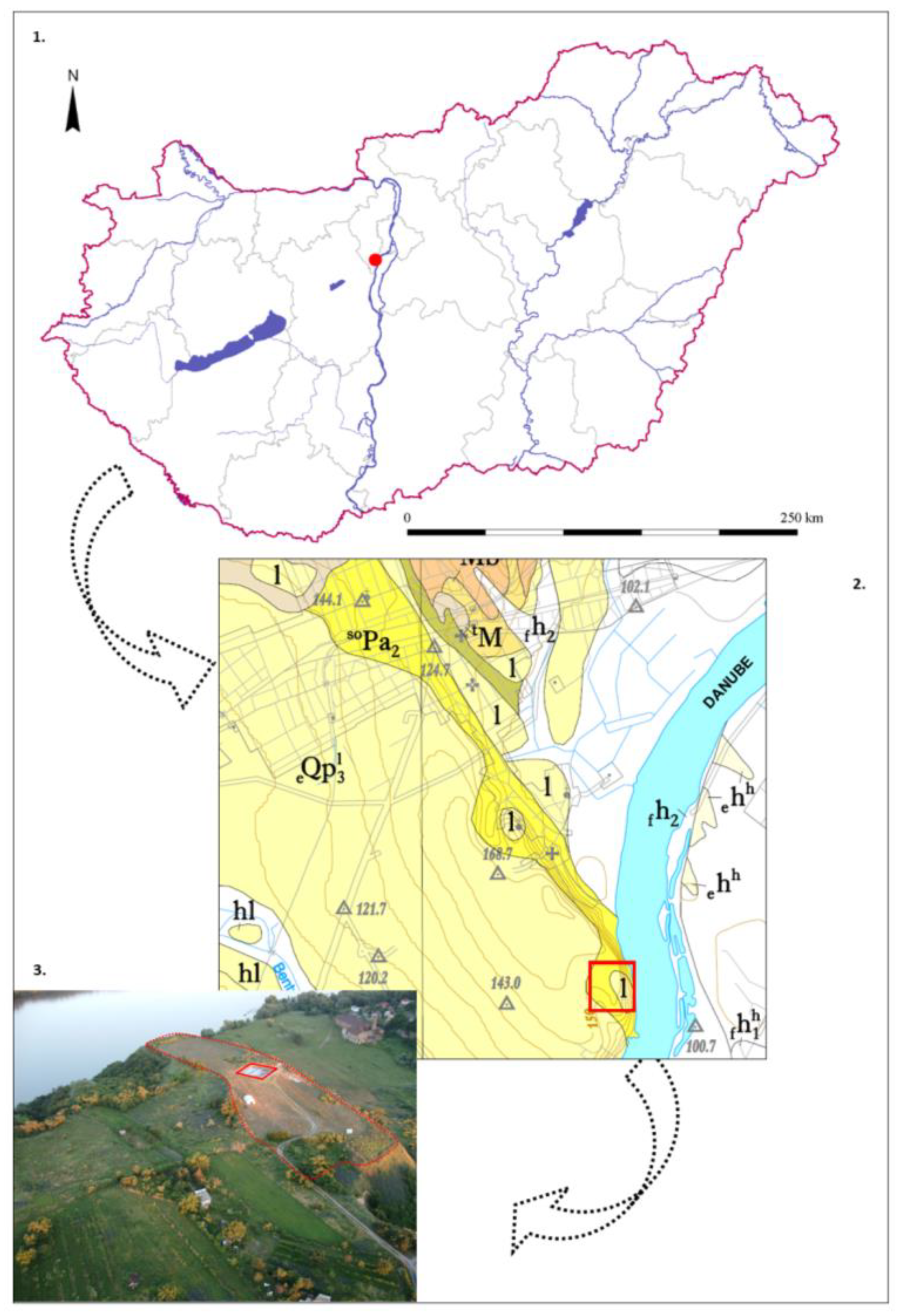

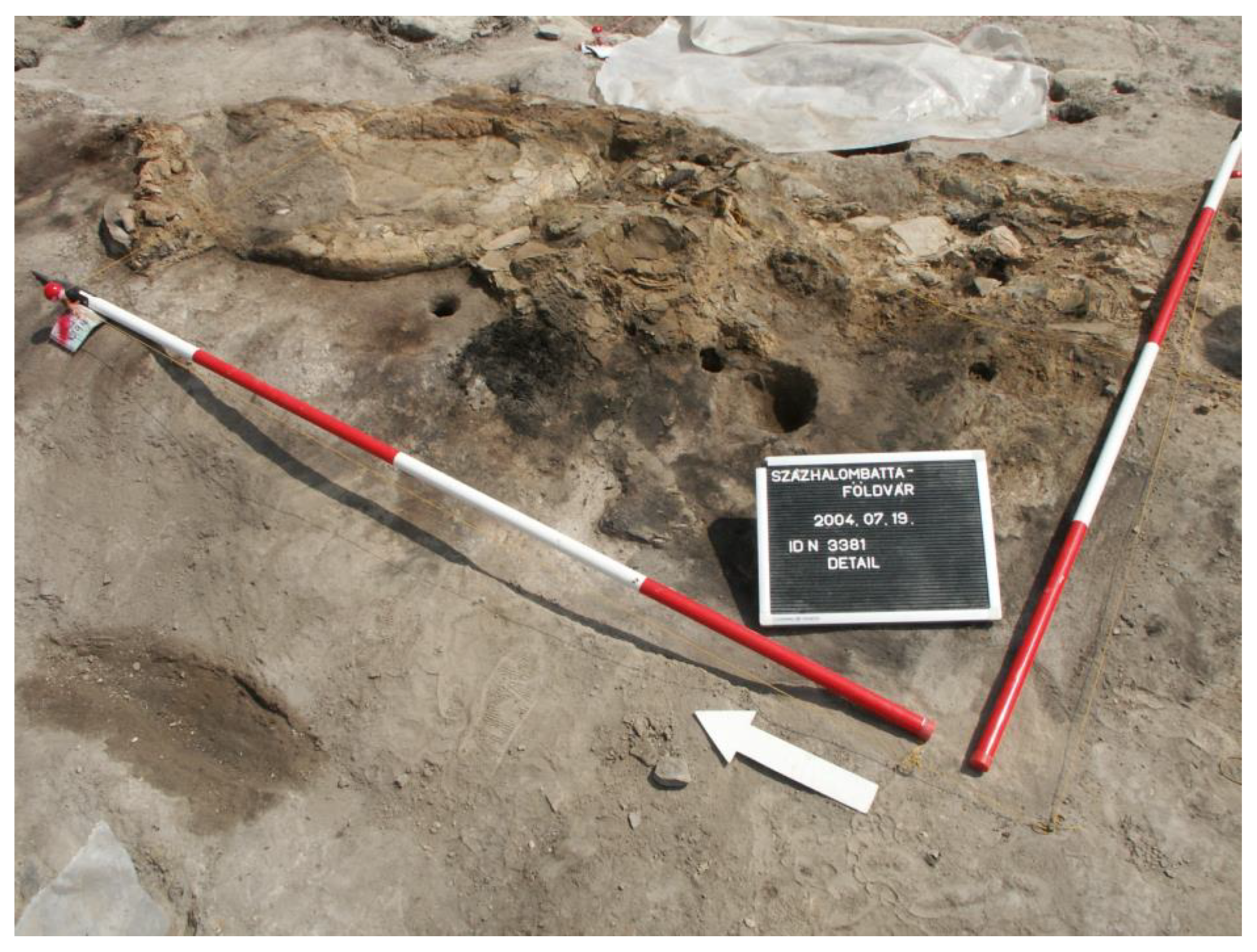


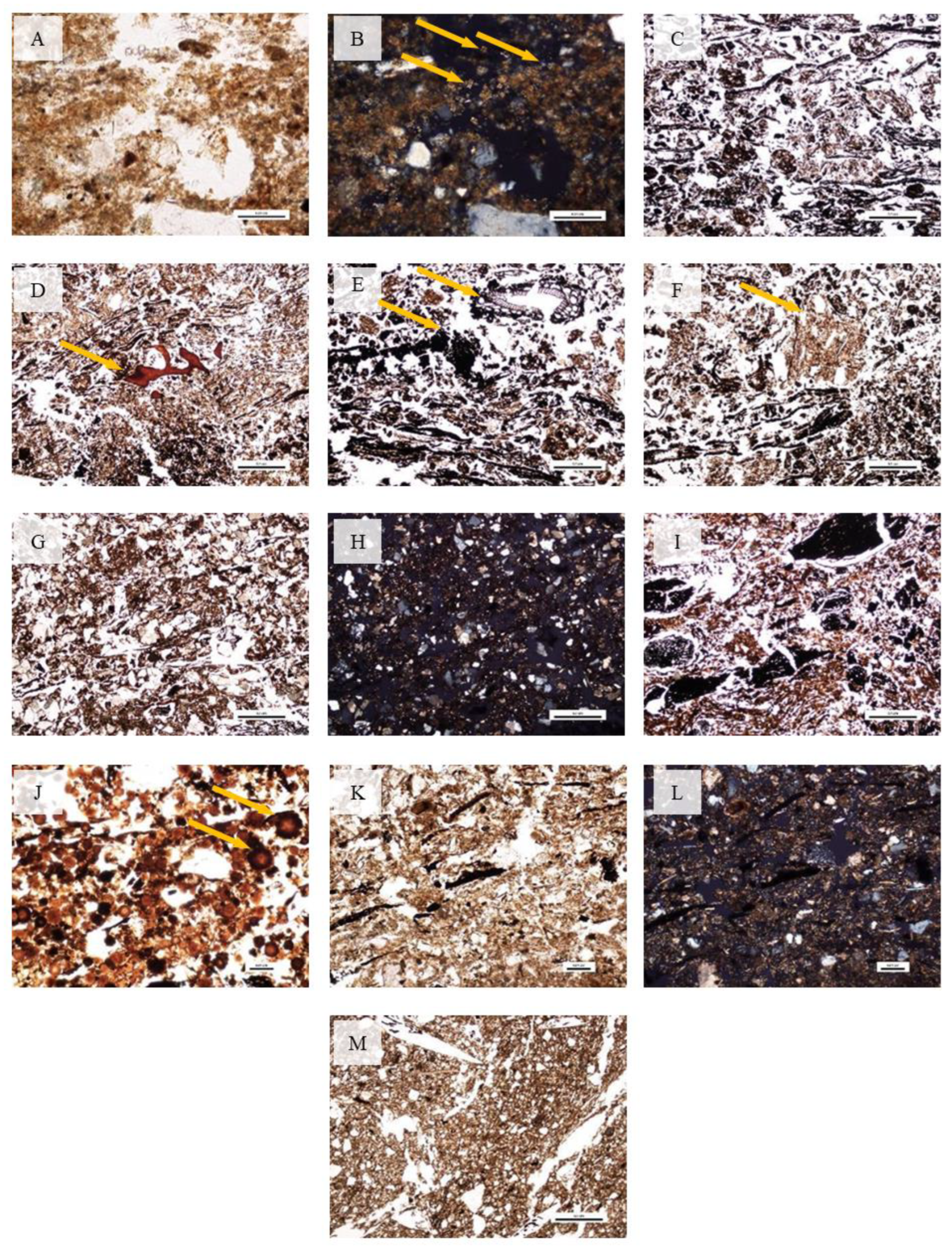
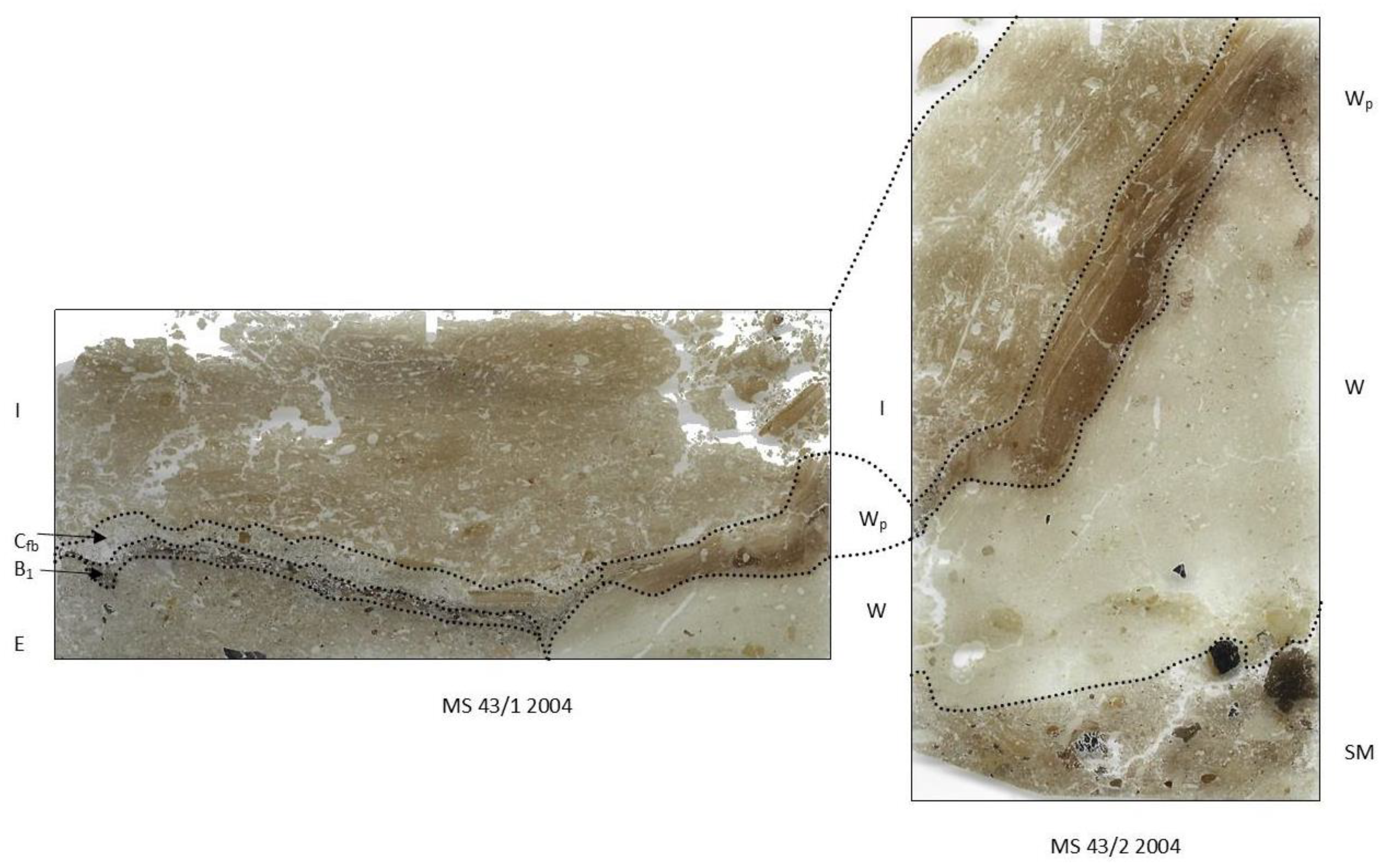
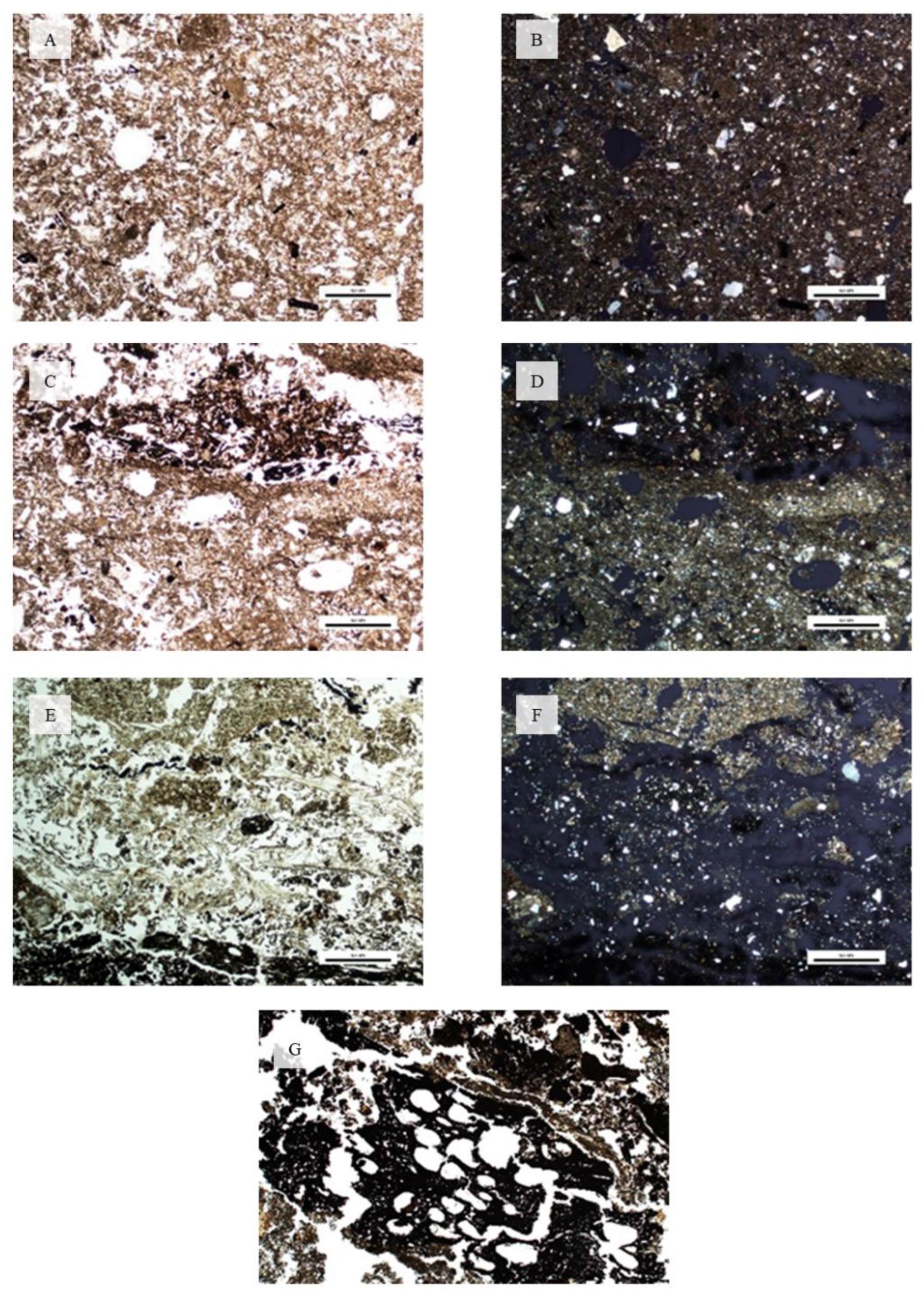
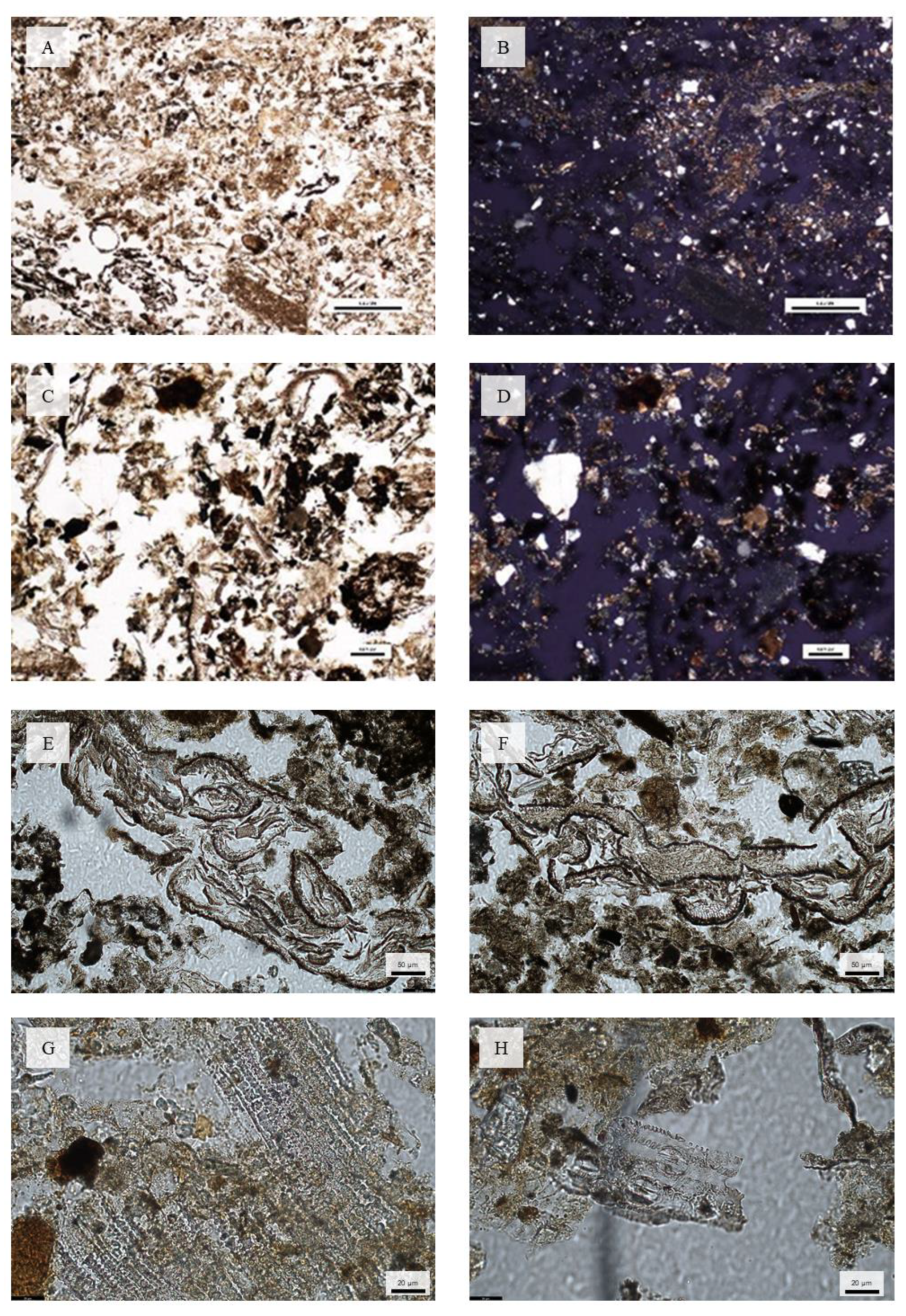

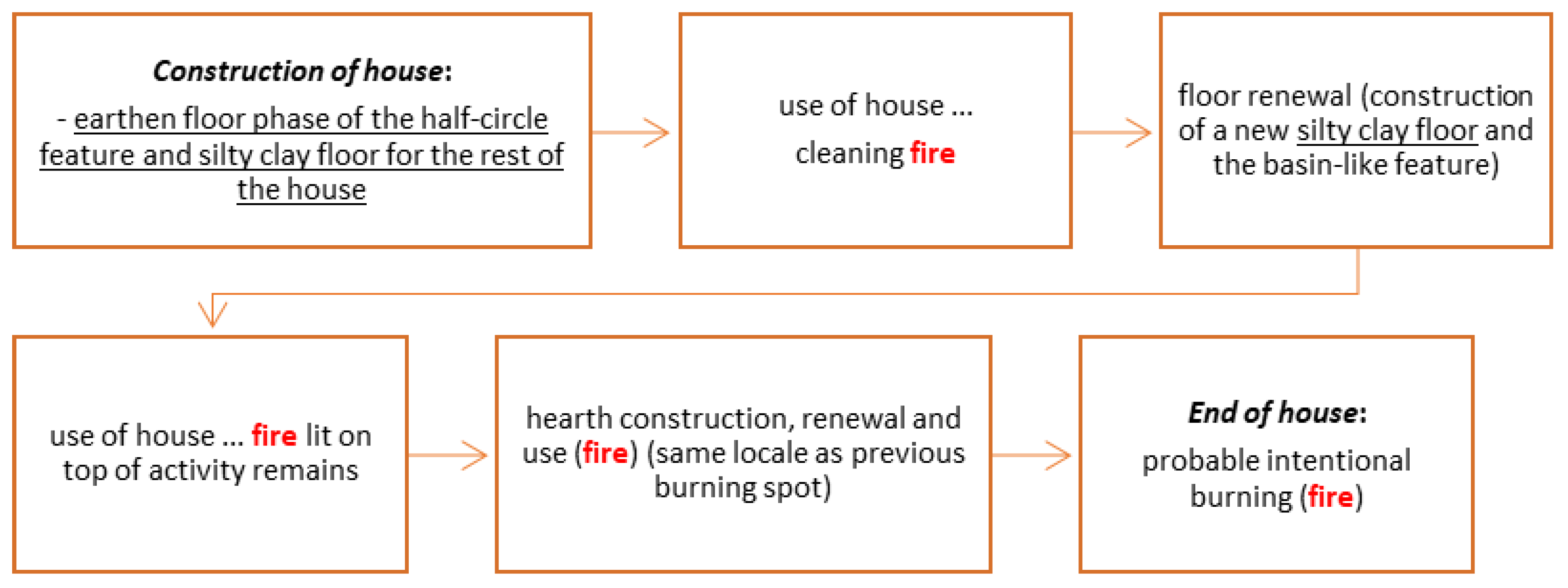
| Sample Code | Description | Stratigraphy/ Micro-Horizons | Archaeological Context of the Stratigraphical Unit | |
|---|---|---|---|---|
| Burning Type #1 | MS32 2004 | Silty clay floor and hearth with burning episodes | Hp2 | Hearth platform 2 |
| Be3 | Burning event 3 | |||
| Be2 | Burning event 2 | |||
| Hp1 | Hearth platform 1 | |||
| Be1 | Burning event 1 | |||
| Cfb/be | Floor build-up/burning event | |||
| C | Silty clay floor | |||
| Burning Type #2 | MS43/1 2004 | Probable cleaning fire | B1 | Burning event |
| Burning Type #3 | MS43/1 2004 | Earthen floor (with cleaning fire and ash dump), clay installation (basin), and burnt wall | I | Installation/furniture (basin) |
| Cfb | Floor build up—ashy layer | |||
| E | Earthen floor | |||
| W | Wall | |||
| MS43/2 2004 | Wall of house ID 3497 with the clay installation | I | Installation/furniture | |
| Wp | Wall replastering | |||
| W | Wall plaster | |||
| SM | Sediment matrix |
| Sample Code | Stratigraphy/Micro-Horizon | Main Characteristics |
|---|---|---|
| MS32 2004 | Hp2 | Fine (c/f 100:10/90), porous (porosity: 30–40%), and undisturbed to slightly bioturbated horizon. Mineral components dominated with some phytoliths (2–5%) and charcoal (<2%). Phytoliths were partly well exposed, which was an indication of vegetative plant organs. |
| Be3 | Fine (c/f 100:20/80), porous (porosity: 30–40%), and slightly to moderately bioturbated horizon. Charcoal (10–20%) dominated with some phytoliths (2–5%) and occasional burnt bone and daub fragments (<2%). Laminated plant deposition and chaff indication. | |
| Be2 | Very fine (c/f 100:5/95), moderately porous (porosity: 20–30%), and slightly to moderately bioturbated horizon. Charcoal (30–50%) dominated with occasional phytoliths (<2%). | |
| Hp1 | Coarser (c/f 100:40/60), slightly porous (porosity: 20–25%), and slightly bioturbated horizon. Charcoal and burnt daub fragments (5–10%) dominated with some burnt bone (2–(5)%) and with occasional burnt phytoliths (<2%) indicating the presence of chaff. | |
| Be1 | Very fine (c/f 100:5/95), porous (30–40%), and highly bioturbated horizon. Charcoal and burnt plaster fragments (30–50%) dominated with some phytoliths (2–5%) and an extremely high content of charred amorphous plant organic matter (POM). | |
| Cfb/be | Fine (c/f 100:10/90), moderately porous (20–30%), and moderately bioturbated horizon. Wall plaster dominated (30–50%) with some charcoal (2–5%) and phytoliths (<2%) as well as charred plant organic matter (POM). Burnt bone fragments were also present (<2%). | |
| C | Very fine (c/f 100:<5/>95), compact (5–10%), and slightly to moderately bioturbated; mainly mineral horizon with some daub (2–5%), a wall plaster fragment (5–10%), and occasional phytoliths (<2%). | |
| MS43/1 2004 | B1 | Very fine (c/f 100: 5/95), moderately porous (porosity: 20–30%), highly bioturbated horizon. Charcoal (30–50%) dominates with some phytoliths (2–5%) and occasional burnt bone and non-metallurgic slag fragments (<2%). |
| I | Very fine (c/f 100: 5/95), porous horizon (porosity: 30–40%) with no/slight bioturbation. Mineral components dominate with some phytoliths (2–5%) and bioclast fragments (<2%). | |
| Cfb | Very fine (c/f 100: 5/95), porous (porosity: 30–40%), highly bioturbated horizon. Phytoliths (30–50%) dominate with some wall and non-metallurgic slag fragments (2–5%) and with occasional charcoal, burnt bone, ash and pottery fragments (<2%). | |
| E | Fine (c/f 100: 10/90), moderately porous (porosity: 20–30%), slightly to moderately bioturbated horizon. Charcoal (5–10%) dominates with some phytoliths, bone and ash (2–5%) and with occasional dung, burnt bone and daub fragments (<2%). Disturbed and mixed-up plant depositions are present. | |
| W | The daub fragment is mainly mineral in composition with some dung (2–5%) and occasional phytoliths, charcoal and pottery fragments (<2%). | |
| MS43/2 2004 | I | Very fine (c/f 100: 5/95), porous (porosity: 40–50%), undisturbed to slightly bioturbated horizon. Mainly mineral horizon with some phytoliths (2-5%) and with occasional dung and bioclast fragments (<2) |
| Wp | Six layers of re-plasterings, which are composed of mainly mineral particles with some charcoal (2–5%) in one of them. The plaster layers are very fine and compact with no, or slight bioturbation. | |
| W | Very fine (c/f 100: 5/95), compact (porosity: 5–10%), undisturbed to slightly bioturbated horizon. Mainly mineral horizon with some dung (2-5%) and with occasional phytoliths, bioclast and charcoal fragments (<2%). | |
| SM | Fine (c/f 100: 15/85), moderately porous (porosity: 25–30%), moderately to highly bioturbated horizon with some phytoliths, charcoal, ash, pottery and daub fragments (2–5%) and with occasional bone and non-metallurgic slag (<2%) |
Disclaimer/Publisher’s Note: The statements, opinions and data contained in all publications are solely those of the individual author(s) and contributor(s) and not of MDPI and/or the editor(s). MDPI and/or the editor(s) disclaim responsibility for any injury to people or property resulting from any ideas, methods, instructions or products referred to in the content. |
© 2023 by the authors. Licensee MDPI, Basel, Switzerland. This article is an open access article distributed under the terms and conditions of the Creative Commons Attribution (CC BY) license (https://creativecommons.org/licenses/by/4.0/).
Share and Cite
Kovács, G.; Vicze, M.; Pető, Á. Fires of a House—Burning Events in a Middle Bronze Age Vatya House as Evidenced by Soil Micromorphological Analysis of Anthropogenic Sediments. Land 2023, 12, 159. https://doi.org/10.3390/land12010159
Kovács G, Vicze M, Pető Á. Fires of a House—Burning Events in a Middle Bronze Age Vatya House as Evidenced by Soil Micromorphological Analysis of Anthropogenic Sediments. Land. 2023; 12(1):159. https://doi.org/10.3390/land12010159
Chicago/Turabian StyleKovács, Gabriella, Magdolna Vicze, and Ákos Pető. 2023. "Fires of a House—Burning Events in a Middle Bronze Age Vatya House as Evidenced by Soil Micromorphological Analysis of Anthropogenic Sediments" Land 12, no. 1: 159. https://doi.org/10.3390/land12010159
APA StyleKovács, G., Vicze, M., & Pető, Á. (2023). Fires of a House—Burning Events in a Middle Bronze Age Vatya House as Evidenced by Soil Micromorphological Analysis of Anthropogenic Sediments. Land, 12(1), 159. https://doi.org/10.3390/land12010159






